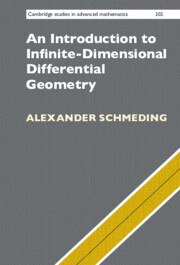Book contents
- Frontmatter
- Contents
- Preface
- 1 Calculus in Locally Convex Spaces
- 2 Spaces and Manifolds of Smooth Maps
- 3 Lifting Geometry to Mapping Spaces I: Lie Groups
- 4 Lifting Geometry to Mapping Spaces II: (Weak) Riemannian Metrics
- 5 Weak Riemannian Metrics with Applications in Shape Analysis
- 6 Connecting Finite-Dimensional, Infinite-Dimensional and Higher Geometry
- 7 Euler–Arnold Theory: PDEs via Geometry
- 8 The Geometry of Rough Paths
- Appendix A A Primer on Topological Vector Spaces and Locally Convex Spaces
- Appendix B Basic Ideas from Topology
- Appendix C Canonical Manifold of Mappings
- Appendix D Vector Fields and Their Lie Bracket
- Appendix E Differential Forms on Infinite-Dimensional Manifolds
- Appendix F Solutions to Selected Exercises
- References
- Index
8 - The Geometry of Rough Paths
Published online by Cambridge University Press: 08 December 2022
- Frontmatter
- Contents
- Preface
- 1 Calculus in Locally Convex Spaces
- 2 Spaces and Manifolds of Smooth Maps
- 3 Lifting Geometry to Mapping Spaces I: Lie Groups
- 4 Lifting Geometry to Mapping Spaces II: (Weak) Riemannian Metrics
- 5 Weak Riemannian Metrics with Applications in Shape Analysis
- 6 Connecting Finite-Dimensional, Infinite-Dimensional and Higher Geometry
- 7 Euler–Arnold Theory: PDEs via Geometry
- 8 The Geometry of Rough Paths
- Appendix A A Primer on Topological Vector Spaces and Locally Convex Spaces
- Appendix B Basic Ideas from Topology
- Appendix C Canonical Manifold of Mappings
- Appendix D Vector Fields and Their Lie Bracket
- Appendix E Differential Forms on Infinite-Dimensional Manifolds
- Appendix F Solutions to Selected Exercises
- References
- Index
Summary
In this chapter, we will discuss the (infinite-dimensional) geometric framework for rough paths and their signature. Rough path theory originated in the 1990s with the work of T. Lyons. It seeks to establish a theory of integrals and differential equations driven by rough signals. For example, one is interested in controlled ordinary differential equations driven by a rough signal. Here, a rough signal is a Hölder continuous path of potentially low Hölder regularity. Numerical methods for equations with more regularity suggest that iterated integrals of the rough signal against itself are needed to construct solutions. However due to Youngs theorem, these iterated integrals do not exist. To compensate this problem, the notion of a rough path was developed. After a qucik introduction to the theory of rough paths, we shall see that rough paths of various flavours can be understood as certain continuous paths taking values in infinite-dimensional Lie groups. The main focus of the chapter is to present an introduction to this geometric side of the theory.
Keywords
- Type
- Chapter
- Information
- An Introduction to Infinite-Dimensional Differential Geometry , pp. 157 - 185Publisher: Cambridge University PressPrint publication year: 2022
- Creative Commons
- This content is Open Access and distributed under the terms of the Creative Commons Attribution licence CC-BY-NC-ND 4.0 https://creativecommons.org/cclicenses/

